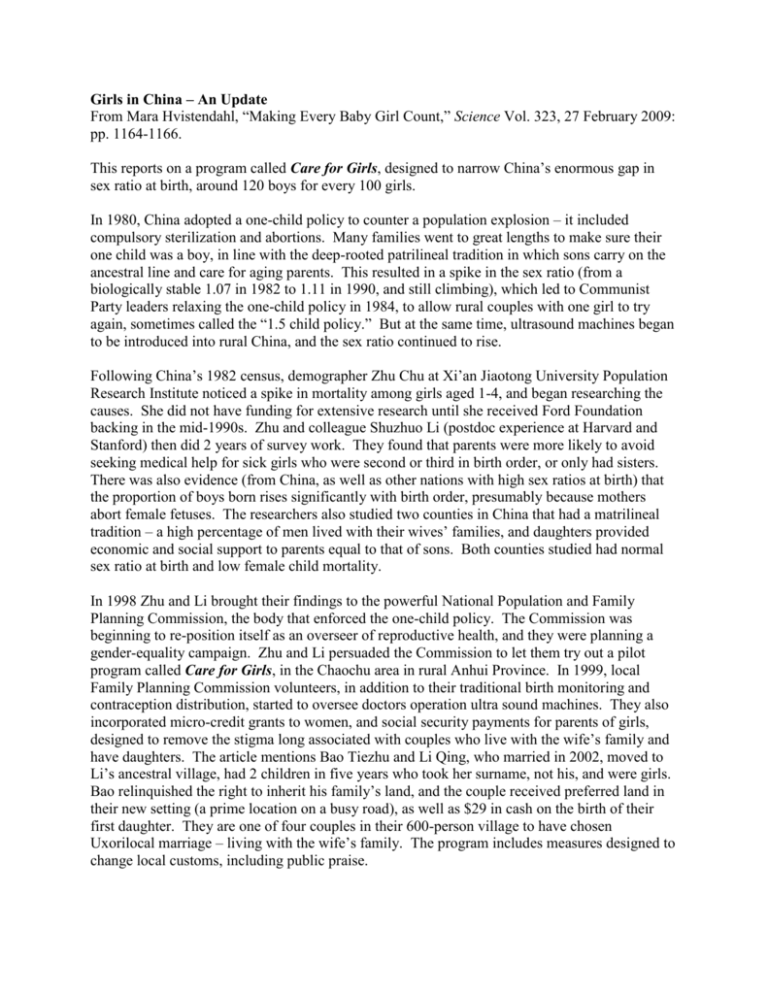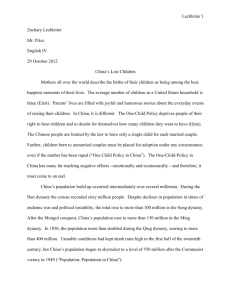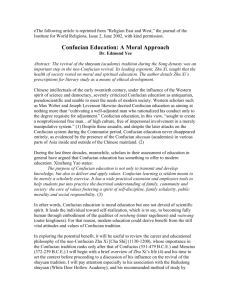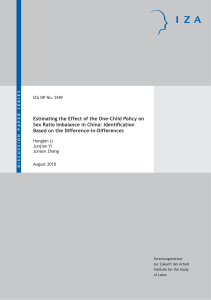Girls in China – An Update
advertisement

Girls in China – An Update From Mara Hvistendahl, “Making Every Baby Girl Count,” Science Vol. 323, 27 February 2009: pp. 1164-1166. This reports on a program called Care for Girls, designed to narrow China’s enormous gap in sex ratio at birth, around 120 boys for every 100 girls. In 1980, China adopted a one-child policy to counter a population explosion – it included compulsory sterilization and abortions. Many families went to great lengths to make sure their one child was a boy, in line with the deep-rooted patrilineal tradition in which sons carry on the ancestral line and care for aging parents. This resulted in a spike in the sex ratio (from a biologically stable 1.07 in 1982 to 1.11 in 1990, and still climbing), which led to Communist Party leaders relaxing the one-child policy in 1984, to allow rural couples with one girl to try again, sometimes called the “1.5 child policy.” But at the same time, ultrasound machines began to be introduced into rural China, and the sex ratio continued to rise. Following China’s 1982 census, demographer Zhu Chu at Xi’an Jiaotong University Population Research Institute noticed a spike in mortality among girls aged 1-4, and began researching the causes. She did not have funding for extensive research until she received Ford Foundation backing in the mid-1990s. Zhu and colleague Shuzhuo Li (postdoc experience at Harvard and Stanford) then did 2 years of survey work. They found that parents were more likely to avoid seeking medical help for sick girls who were second or third in birth order, or only had sisters. There was also evidence (from China, as well as other nations with high sex ratios at birth) that the proportion of boys born rises significantly with birth order, presumably because mothers abort female fetuses. The researchers also studied two counties in China that had a matrilineal tradition – a high percentage of men lived with their wives’ families, and daughters provided economic and social support to parents equal to that of sons. Both counties studied had normal sex ratio at birth and low female child mortality. In 1998 Zhu and Li brought their findings to the powerful National Population and Family Planning Commission, the body that enforced the one-child policy. The Commission was beginning to re-position itself as an overseer of reproductive health, and they were planning a gender-equality campaign. Zhu and Li persuaded the Commission to let them try out a pilot program called Care for Girls, in the Chaochu area in rural Anhui Province. In 1999, local Family Planning Commission volunteers, in addition to their traditional birth monitoring and contraception distribution, started to oversee doctors operation ultra sound machines. They also incorporated micro-credit grants to women, and social security payments for parents of girls, designed to remove the stigma long associated with couples who live with the wife’s family and have daughters. The article mentions Bao Tiezhu and Li Qing, who married in 2002, moved to Li’s ancestral village, had 2 children in five years who took her surname, not his, and were girls. Bao relinquished the right to inherit his family’s land, and the couple received preferred land in their new setting (a prime location on a busy road), as well as $29 in cash on the birth of their first daughter. They are one of four couples in their 600-person village to have chosen Uxorilocal marriage – living with the wife’s family. The program includes measures designed to change local customs, including public praise. Is the Family Planning Commission the right body to oversee this program, given that it still fines parents for exceeding the one or 1.5 child policy? Would it be better to scrap the one child policy altogether? On the other hand, would that solve the sex ratio problem, given that rising sex ratios are also being experienced across Asia (including in India) in countries that don’t limit the number of children parents can have? (Haryana State in India in 1994 started paying parents for having girls, and in 2008 this program was extended by the national government to seven other states). And the Commission does have the power to bring about rapid social change, using its army of more than 300,000 volunteer workers. Li and Zhu argue for further relaxing the one-child policy, but they also argue that, although it may exacerbate the sex ratio problem, it doesn’t directly cause it. “The essential problem is culture. And Chinese culture can be changed.” (Shuzhuo Li) Li now believes that a decade of work is paying off. Chaohu’s sex ratio dropped from 125 in 1999 to 114 in 2002. In the year 2000, the Chinese government scaled up the program to 24 districts around the country (in some of these districts the sex ratio dropped from 134 in 2000 to 120 in 2005). In the year 2006, Care for Girls became a nationwide program. Have the gains mostly come from a crackdown on sex selection, rather than deeper cultural change? Other factors helping are the trend to urbanization (some scholars think this reduced the sex ratio in South Korea), and increases to women’s earning power coming from flows of migrant workers to wealthy cities in eastern China, with their introduction of new ideas into the countryside. Chinese Men: A Rising Tide of Troublemakers? The flip side of the problem: men who can’t find wives, called guang gun, or “bare branches.” Over the next two decades there will be at least 30 million Chinese men in this category. Those who lose out tend to be at the bottom of the social ladder – rural, uneducated, marginally employed, often transient. Some authors have argued they could be become a “rogue underclass…who could stir up political instability and even armed revolts.” Others disagree. Over long history, 10% of Chinese males never married, because the sex ratio has been skewed for a long time, as a result of female infanticide. But there is no clear evidence, either from China or from other countries that have experienced the phenomenon, that they will join rebellions. The worst consequences could be loneliness and lack of social support. Li and colleagues are intent on finding out, by doing a survey of bachelors over the age of 28 to find out their circumstances in education, finances, physical and mental health, drinking, sex lives, and social connections.











